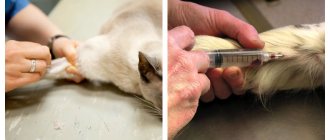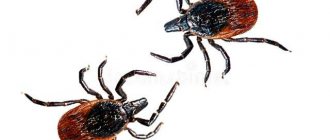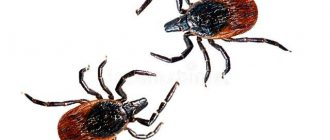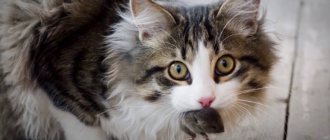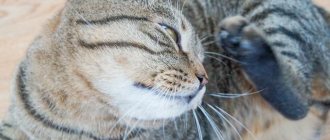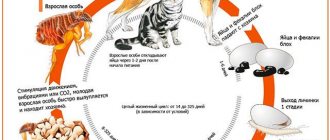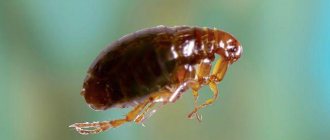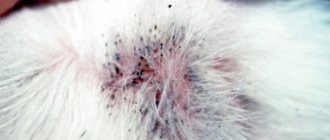Currently, pet stores have a large selection of products for getting rid of insects from adult cats. But how to remove fleas from a kitten? This task is not easy, since it is not recommended to treat babies with traditional medications intended for adult animals. The kitten is constantly licked by the mother, and the medicine, entering the cat’s esophagus, then ends up in her milk, which can cause much more harm to the baby than fleas.
In this regard, there are differences in the methods of removing fleas from newborn kittens and those whose age is 1 month or more.
Distinctive features of cat fleas
Cat fleas are one of the most common types of fleas. However, despite their name, they affect not only cats, but also dogs, as well as humans. Cat fleas are carriers of many dangerous diseases, and therefore it is necessary to know their distinctive features.
External difference from other types of fleas
Cat fleas are related parasites of rat and dog fleas. At the same time, they have a number of external features:
- brown or black shiny color;
- body size from 0.5 to 2 mm;
- wings are missing;
- long hind limbs that allow the flea to jump up to half a meter.
The cat flea is a small, but very nimble and dangerous insect.
These small insects move very quickly, hide deep in the animal’s fur, closer to the skin, so it is practically impossible to notice them on the fur. The flea's body has a strong shape elongated in height and laterally compressed, which allows it to move deftly in the fur, jump high and protect itself from simple mechanical compression. It is much easier to notice the insect on a person due to the lack of fur, but it is also difficult to catch and destroy.
Methods and reasons for the appearance of fleas in animals and in the house
Even careful care of your pet does not guarantee the absence of fleas. Often cat owners are surprised where their pet got annoying parasites if the domestic cat doesn’t even leave the house.
There are several ways to become infected with cat fleas:
- through other pets;
- through street clothes and shoes;
- through the entrance of a residential building;
- through basements, cracks, neighboring rooms;
- through rodents (eg rats and mice).
The highest probability of infection occurs in the autumn-summer period. A favorable breeding environment for fleas is dampness, lack of ventilation, and clutter. Most often, private houses and apartments on the first floors are susceptible to flea attacks. Insect larvae and eggs can be found in the most hidden places: baseboards, cracks in the floor, carpets, furniture, clothes, cat bed. Bloodsuckers reproduce very quickly, and therefore it is important to promptly detect their appearance and begin the fight.
The first signs of fleas in a cat are quite difficult to identify, since they do not appear in any way, except for a little more frequent scratching. However, as the number of attacking individuals increases, you may notice a change in the pet’s behavior - the appearance of severe anxiety due to constant itching. Scratched bite spots form on the skin, small black dots can be found on the stomach, in serious cases, hair may begin to fall out, abscesses and allergic dermatitis may form.
Danger to animals and humans
The appearance of cat fleas on a pet is fraught with infection with infectious diseases, including those fatal to the cat. Fungal, skin diseases, worms, and in children the development of anemia, developmental delay, even death, are the consequences of untimely destruction of parasites.
Cat fleas will not bypass you and your household. In humans, exposed areas of the body are most often attacked - legs, arms, back, stomach. In addition to the unpleasant itching, a flea bite is dangerous for humans due to the possibility of transmitting diseases such as typhus, encephalitis, salmonellosis, plague, worms and other diseases.
Cat fleas pose a threat to humans
Although humans are not the preferred target for cat fleas, if they appear on a pet, there is a high probability that the insect will not miss a large and easily accessible flea such as a person. A flea appears on a human body only during a bite, unlike an animal, in whose fur the parasites can even lay eggs.
Therefore, it is very important to start the fight against bloodsuckers in time.
Habitats
Having found out where fleas come from, it is necessary to determine their favorite habitats.
This:
- floor coverings: parquet, laminate, linoleum, carpet, carpet;
- cloth;
- bed sheets;
- Kids toys;
- bin;
- cushioned furniture;
- pet bedding;
- baseboards, gaps between them.
Parasites can live in wardrobes. There they make nests in the cracks of furniture and linens. Often such insects are found in birds kept in cages.
Methods for removing fleas from a cat
There is quite a wide variety of methods and means of getting rid of fleas. But most often the most effective is a set of measures, especially if the number of insects is high. To completely destroy the larvae and eggs, it is possible to use special chemicals, which must be used only in accordance with the instructions for them in order to protect yourself and your pet.
Fighting methods - comprehensive instructions
To fight effectively, it is necessary to develop a clear action plan, including the following methods:
- First of all, it is necessary to understand the reason for the appearance of cat fleas (infection through an animal or possible penetration of fleas into the room through cracks, basements, etc.);
- Remove parasites from your pet and protect it from re-infection;
- Seal gaps, joints, cracks in doorways, floors, baseboards. If you have a basement and suspect the presence of fleas there, contact a specialized service for treatment;
- Carry out a wet general cleaning of the room, vacuuming, ventilating, cleaning pillows and blankets;
- Choosing a suitable means to control insects in the house (chemical or folk). When processing a room, it is important to remember the following rules:
- a product must be chosen that can destroy not only adults, but also larvae and eggs;
- treatment must be carried out in all rooms using a continuous method (larvae can hide in the most secluded places, especially damp and warm, and therefore the bathroom must also be treated);
- it is necessary to follow the instructions for keeping the room after treatment (treated non-working and non-contact surfaces should not be subjected to wet cleaning during the period of action of the drug);
- Carrying out preventive measures to protect the premises and animals from re-infection.
Means of struggle
The following flea remedies for cats are available:
- Shampoos are a fairly harmless product; there are special ones for babies and mothers. The main difficulty lies in application, since not all cats are calm about water procedures. However, the resulting effect is worth the effort;
- drops - applied to the skin in the withers area, suitable for both cats sitting at home and those who like to go for a walk. It is necessary to follow the instructions for use (cannot always be used for kittens and nursing cats);
- collars are impregnated with insecticides, the main disadvantage is that irritation on the neck from the strap may occur; it is also not recommended for free-roaming cats to use it, so as not to accidentally get the collar caught on something and not be able to get out; it is not advisable to use it for sick cats, kittens and mothers ;
- sprays - sprayed onto the cat's fur, has a fast-acting effect, the main condition is not to get on the mucous membranes and not allow the cat to lick the fur until the product is completely absorbed, limitation - cannot be used for babies and nursing cats;
- tablets are a fairly effective remedy if you can get your pet to eat the drug, since many people categorically refuse medications in tablet form.
A large selection of flea remedies allows you to both get rid of parasites and protect against their further appearance.
Many people prefer to use folk remedies, due to the fact that they are less toxic and are suitable for most cats:
- wormwood - boil in boiling water, apply the resulting cooled broth to the cat’s skin, repeat treatment as necessary;
- essential oils are a safe product; cedar, lavender, geranium, and mint are good; 2-3 drops per 3 glasses of water are enough to spray an animal; you can add them to shampoo;
- salt - prepare a solution at the rate of 50 g per 1 liter of water, so that you can immerse the animal in it up to the neck, hold for 5 minutes and then rinse with warm water;
- tar soap - immerse a bar of soap in water and foam, rub the cat’s fur with the resulting solution, leave for 5 minutes, then rinse with plenty of water, the remaining smell from the soap will additionally protect against the appearance of fleas.
Folk remedies for fleas are safe for sick, pregnant cats and kittens
Physical method
To get rid of cat fleas, you can treat your apartment with a steam generator or steamer. Insects, their eggs, and larvae do not tolerate strong heat. At temperatures above 45°C they die.
Steam treats carpets, upholstered furniture, floors and baseboards. Activities are carried out every 10 days until the cat fleas are completely eliminated.
For your information. You should choose steam generators that operate in a horizontal position. Some models do not have this feature.
It is not possible to get rid of all parasite eggs at once. They may be in some secluded corner of the apartment where steam does not reach. After some time, larvae will appear from them, and the fleas will begin to reproduce again.
Removing fleas from kittens
Fleas pose a danger to cats and people, but the consequences are especially dire for kittens. Bites can cause babies to develop anemia, which can be fatal.
The most dangerous consequences of flea bites are for newborn kittens.
Infection most often occurs from mother cats, but the affected area and the number of attacking individuals in kittens are much higher. Accordingly, the process of removing parasites is much more complicated, since it is impossible to use chemicals on cubs.
The safest way is to comb from the scruff of the neck along the back, belly and paws. You can also use folk remedies: a decoction of wormwood for bathing or laying out dry branches in the cat’s habitat; tar soap, the foam of which is rubbed into the kitten’s fur; bathing in a weak saline solution.
There are also special flea shampoos for kittens. However, before use, you must consult your veterinarian and carefully follow the instructions.
For babies older than six months, you can use essential oils, collars and special insecticides, but those marked are allowed for kittens. In any case, when choosing a product, it is better to consult a specialist.
Treatment of a pregnant and lactating cat
The choice of methods for getting rid of fleas in a pregnant and lactating cat, as well as in kittens, must be approached very carefully. To do this, you must follow the following rules:
- Be sure to consult a veterinarian;
- wash, or better yet, boil the bedding on which the cat sleeps;
- clean and disinfect the premises.
It is acceptable to use gentle and low-toxic drugs: shampoos, collars and drops.
The less toxic the flea remedy, the safer it is for the expectant or new mother.
However, it is necessary to remember that the stress of bathing is harmful for mothers and if your cat does not like water, then it is better to choose another remedy. Collars and shampoos do not penetrate the skin and do not have a toxic effect on the fetus, unlike drops, and therefore consultation with a specialist is required before using them. For nursing cats, collars are not always a suitable option, as kittens may lick them while crawling on their mother.
Therefore, the best option for anti-flea remedies may be folk remedies, and simply combing out the pet’s fur.
How to enhance the effect of using folk remedies
If you make a garlic solution, then add 2 tsp to it to enhance the effect. brewer's yeast. Herbal solutions are not just watered, but soaked into the pet’s skin. If you use essential oils, it is recommended to mix several types at once.
When processing an animal, the entire room must be disinfected. Otherwise, fleas may temporarily find another habitat and then return to the pet’s fur. After treatment with products with strong odors, the room is ventilated at least after 8 hours.
Room treatment
In the fight against parasites, room treatment plays an important role, since fleas are on the victim only at the time of the bite, but they can live and lay eggs in any secluded places.
First of all, it is necessary to thoroughly clean the apartment: vacuum, including upholstered furniture, and wet clean all hard-to-reach places using tar soap, soda, and vinegar. Bedding, soft toys, and cat litter must be washed; for this, you can prepare decoctions of wormwood, lavender, or tansy. After wet cleaning, surfaces can be rinsed with water with the addition of essential oils.
Carpets and rugs must be vacuumed, if possible, knocked out on the street, and also treated with a special anti-flea preparation. It is also possible to disinfect upholstery and carpeting using a steam generator. As a rule, one treatment with a vacuum cleaner or steam generator will not be enough; the procedure must be repeated within a week or two. High-pile carpets are treated with special sprays (Dichlorvos, Raptor, Reid and others), and then thoroughly cleaned. When processing the spray, it is better not to just spray it on the carpet, but to rub it into the pile using rubber gloves. After treating the carpet surface, at least a day should pass before the carpet is cleaned. You can clean the carpet using a brush with a soapy solution with the addition of soda.
Even if fleas appeared in the house through an animal and they were successfully removed, cleaning and disinsection of the premises is a prerequisite
After preliminary cleaning, it is necessary to treat the room with insecticidal agents. When choosing flea products, it is recommended to be guided by the following requirements for them: effectiveness, ease of use, absence of stains on furniture after treatment, speed, presence of various active ingredients.
Basic means for processing an apartment can be grouped as follows:
- aerosols are the most popular means, as they do not require additional preparation during processing and cover a large area of the room when sprayed (Raptor, Dichlorvos, Raid, Combat);
- powders - scatter in the habitats of fleas in the apartment, but it is necessary to exclude the possibility of access to these places by animals and children (Peretrum, Domovoy, Fenaxin, Clean House and others);
- Concentrates for preparing a solution are economical, since a large volume of solution can be obtained from one tube after dilution, but they are more suitable for disinfestation by specialists, since to be effective, it is necessary to properly dilute the concentrate and use special protective agents (Chlorpyrimac, Get, Biorin).
The choice of a product for treating fleas at home is an individual matter, especially since there are a lot of options. In case of severe infestation, it may be necessary to use a set of measures that includes several anti-flea products. The main thing to remember is that you must use chemicals strictly in accordance with the attached instructions, protecting yourself, children and animals as much as possible from possible contact of the substance with the mucous membranes and inside the body.
Actions after disinfestation
You should enter a cleaned and treated apartment after it has been thoroughly ventilated. Carry out wet cleaning of places that have to be touched, except for the floor. When sprayed, the chemical may accidentally get on door handles, armrests, or table surfaces. Treatment with a soap-soda solution neutralizes the effects of the insecticide.
Types of fleas.
The bed is covered with clean linens, armchairs and sofas are covered with washed bedspreads. Then the lid is removed from the aquarium, the artificial air compressor is turned on, and children and pets are brought in. It is not recommended to wash the floor for 2 weeks after treatment. Upholstered furniture and floor coverings should be vacuumed every day to remove dead insects.
Preventive measures
After ridding the animal and housing of fleas, the main question arises - how to prevent re-infestation. Unfortunately, there is a possibility of insects being introduced due to reasons beyond our control. However, there are a number of measures that, if observed, will help minimize the risk of reappearance of parasites:
- maintain order in the house, clean, wash and shake out cat litter;
- with the beginning of the spring-summer season, protect your pet from fleas using special means (collars, drops, sprays, etc.);
- try to limit your cat’s contact with infected animals.
Such very simple methods can save you and your ward from a lot of hassle in the fight against fleas. After all, it is much easier to prevent a threat than to deal with its consequences.
